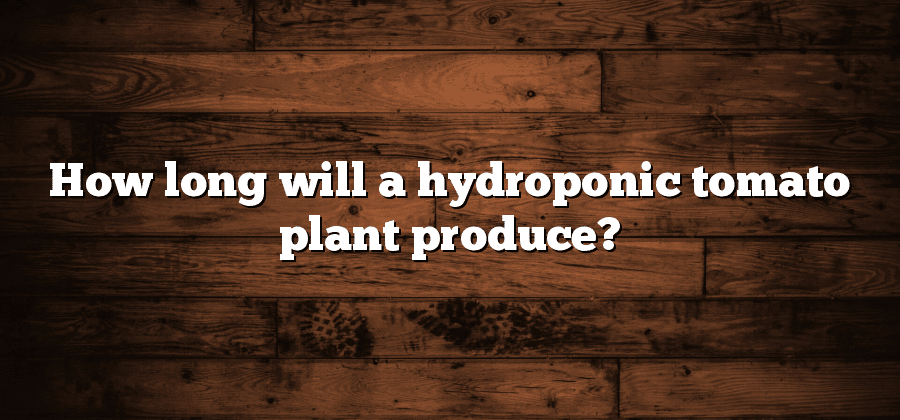Factors affecting the lifespan of hydroponic tomato plants
One of the primary factors that can influence the lifespan of hydroponic tomato plants is the quality of the nutrient solution. Tomato plants rely on a well-balanced mixture of essential nutrients to thrive, and any imbalance or deficiency can have detrimental effects on their overall health and lifespan. It is crucial to regularly monitor and adjust the nutrient solution to ensure that it meets the specific nutritional needs of the tomato plants.
In addition to the nutrient solution, another factor that can impact the lifespan of hydroponic tomato plants is the environmental conditions. Temperature, humidity, and light levels all play a crucial role in the growth and development of tomato plants. Extreme temperatures can stress the plants and reduce their lifespan, while inadequate lighting or improper humidity levels can affect their ability to photosynthesize and produce fruit. Creating an optimal environment by controlling these factors within the hydroponic system can significantly extend the lifespan of the tomato plants and maximize their productivity.
Understanding the growth stages of hydroponic tomato plants
Tomato plants cultivated hydroponically go through various distinct growth stages. These stages are crucial milestones in the plant’s development and can help growers understand and manage their plants more effectively. The first stage is seed germination, where the seeds begin to sprout and develop roots. This process usually takes around 5-10 days, depending on various factors such as temperature, moisture, and seed quality.
After germination, the seedlings enter the vegetative stage, characterized by leaf and stem development. During this phase, the plants primarily focus on producing a strong and healthy root system. Adequate lighting, correct nutrient balance, and optimal environmental conditions are crucial to promote vigorous growth. This stage usually lasts for 3-4 weeks before the plants transition into the next stage of their growth journey.
The average lifespan of hydroponic tomato plants
Hydroponic tomato plants, when properly cared for, can have a lifespan ranging from 6 to 12 months. Several factors contribute to the average lifespan, including genetics, environmental conditions, and maintenance practices. It is important to select tomato varieties that are known for their resilience and longevity in hydroponic systems. By choosing well-adapted strains, growers can ensure that their plants are more likely to thrive and produce high yields for an extended period of time.
Environment plays a crucial role in determining the lifespan of hydroponic tomato plants. Temperature, humidity, and lighting all need to be carefully controlled to create optimal growing conditions. Hydroponic systems provide the advantage of allowing growers to manipulate these factors to meet the plants’ specific needs. By maintaining a stable and ideal environment, the lifespan of hydroponic tomato plants can be extended. Additionally, regular monitoring of nutrient levels, pH balance, and water quality can help prevent nutrient deficiencies or imbalances that can shorten the lifespan of the plants.
Maximizing the productivity of hydroponic tomato plants
To maximize the productivity of hydroponic tomato plants, it is essential to pay close attention to their nutrient requirements. These plants rely heavily on nutrient solutions to grow and flourish, so it is crucial to provide them with a well-balanced and carefully monitored nutrient mix. Monitoring the pH levels of the nutrient solution is also important, as an imbalanced pH can hinder nutrient absorption and ultimately impact the plant’s productivity. Regularly testing and adjusting the pH levels can ensure that the hydroponic tomato plants are receiving optimal nutrition for their growth.
Another key factor in maximizing productivity is maintaining appropriate lighting conditions. Hydroponic tomato plants thrive under specific light spectrums, such as blue and red light, which promote photosynthesis and flowering. Therefore, it is crucial to use high-quality grow lights that emit the right spectrum of light for tomato plant growth. Additionally, ensuring that the plants receive the correct amount of light per day is crucial, as insufficient lighting can lead to stunted growth and reduced productivity. By providing the plants with the right combination of lighting, nutrients, and monitoring their overall health, hydroponic gardeners can significantly increase the productivity of their tomato plants.
Signs that indicate the end of a tomato plant’s productivity
One clear sign that a tomato plant’s productivity is coming to an end is the yellowing and wilting of leaves. As the plant nears the end of its life cycle, the leaves may start to turn yellow or brown, and they may become soft and droopy. This is a natural process as the plant redirects its energy to the production of fruit. However, if the majority of the leaves are affected, it could indicate a decline in productivity.
Another sign to look out for is the decreased production of flowers and fruit. A healthy tomato plant typically produces an abundance of flowers, which eventually turn into fruit. However, as the plant reaches the end of its lifespan, the number of flowers and fruit may start to decrease. This can be attributed to a decrease in the plant’s overall vigor and vitality. It is important to monitor and assess the productivity of the plant regularly to determine if it is reaching the end of its lifecycle.






